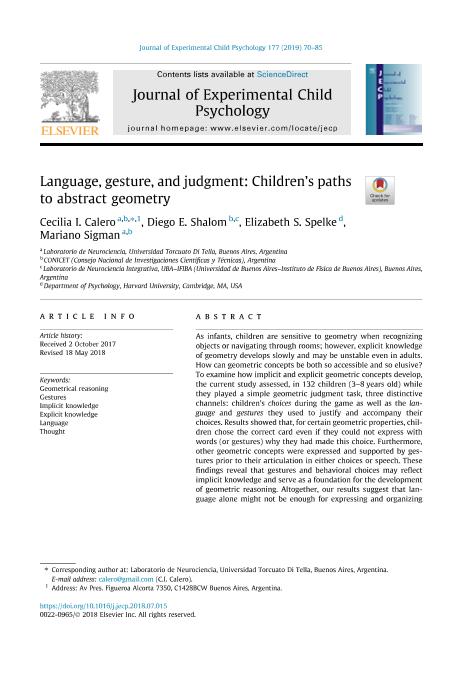Mostrar el registro sencillo del ítem
dc.contributor.author
Calero, Cecilia Ines

dc.contributor.author
Shalóm, Diego Edgar

dc.contributor.author
Spelke, Elizabeth S.
dc.contributor.author
Sigman, Mariano

dc.date.available
2022-11-15T12:43:20Z
dc.date.issued
2018-10
dc.identifier.citation
Calero, Cecilia Ines; Shalóm, Diego Edgar; Spelke, Elizabeth S.; Sigman, Mariano; Language, gesture, and judgment: Children's paths to abstract geometry; Academic Press Inc Elsevier Science; Journal of Experimental Child Psychology; 177; 10-2018; 70-85
dc.identifier.issn
0022-0965
dc.identifier.uri
http://hdl.handle.net/11336/177792
dc.description.abstract
As infants, children are sensitive to geometry when recognizing objects or navigating through rooms; however, explicit knowledge of geometry develops slowly and may be unstable even in adults. How can geometric concepts be both so accessible and so elusive? To examine how implicit and explicit geometric concepts develop, the current study assessed, in 132 children (3–8 years old) while they played a simple geometric judgment task, three distinctive channels: children’s choices during the game as well as the language and gestures they used to justify and accompany their choices. Results showed that, for certain geometric properties, children chose the correct card even if they could not express with words (or gestures) why they had made this choice. Furthermore, other geometric concepts were expressed and supported by gestures prior to their articulation in either choices or speech. These findings reveal that gestures and behavioral choices may reflect implicit knowledge and serve as a foundation for the development of geometric reasoning. Altogether, our results suggest that language alone might not be enough for expressing and organizing geometric concepts and that children pursue multiple paths to overcome its limitations, a finding with potential implications for primary education in mathematics.
dc.format
application/pdf
dc.language.iso
eng
dc.publisher
Academic Press Inc Elsevier Science

dc.rights
info:eu-repo/semantics/openAccess
dc.rights.uri
https://creativecommons.org/licenses/by-nc-sa/2.5/ar/
dc.subject
EXPLICIT KNOWLEDGE
dc.subject
GEOMETRICAL REASONING
dc.subject
GESTURES
dc.subject
IMPLICIT KNOWLEDGE
dc.subject
LANGUAGE
dc.subject
THOUGHT
dc.subject.classification
Otras Ciencias Naturales y Exactas

dc.subject.classification
Otras Ciencias Naturales y Exactas

dc.subject.classification
CIENCIAS NATURALES Y EXACTAS

dc.title
Language, gesture, and judgment: Children's paths to abstract geometry
dc.type
info:eu-repo/semantics/article
dc.type
info:ar-repo/semantics/artículo
dc.type
info:eu-repo/semantics/publishedVersion
dc.date.updated
2022-11-14T11:19:22Z
dc.journal.volume
177
dc.journal.pagination
70-85
dc.journal.pais
Suiza

dc.description.fil
Fil: Calero, Cecilia Ines. Universidad Torcuato Di Tella; Argentina. Consejo Nacional de Investigaciones Científicas y Técnicas; Argentina
dc.description.fil
Fil: Shalóm, Diego Edgar. Consejo Nacional de Investigaciones Científicas y Técnicas. Oficina de Coordinación Administrativa Ciudad Universitaria. Instituto de Física de Buenos Aires. Universidad de Buenos Aires. Facultad de Ciencias Exactas y Naturales. Instituto de Física de Buenos Aires; Argentina
dc.description.fil
Fil: Spelke, Elizabeth S.. Harvard University; Estados Unidos
dc.description.fil
Fil: Sigman, Mariano. Universidad Torcuato Di Tella; Argentina. Consejo Nacional de Investigaciones Científicas y Técnicas; Argentina
dc.journal.title
Journal of Experimental Child Psychology
dc.relation.alternativeid
info:eu-repo/semantics/altIdentifier/url/https://www.sciencedirect.com/science/article/pii/S0022096517306252
dc.relation.alternativeid
info:eu-repo/semantics/altIdentifier/doi/http://dx.doi.org/10.1016/j.jecp.2018.07.015
Archivos asociados
